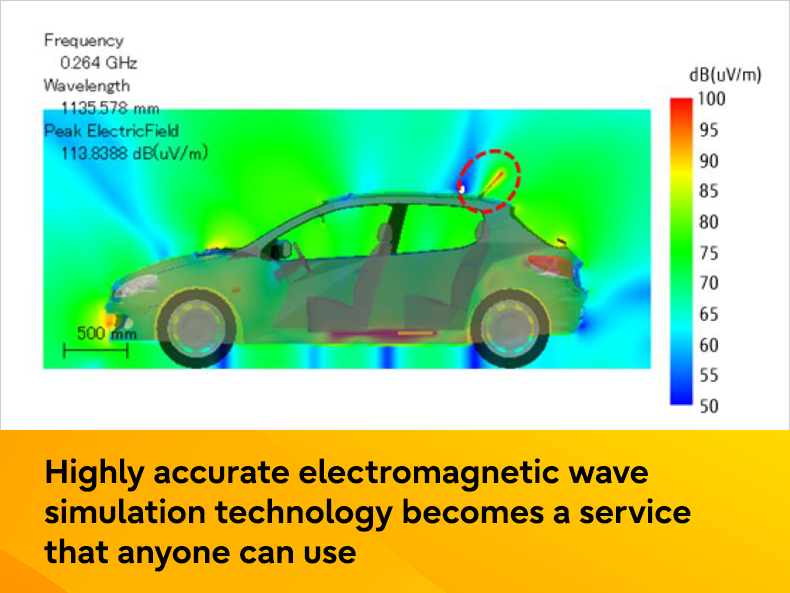- Table of Contents
-
- The demand for electromagnetic simulation, which evaluates electromagnetic interference and communication quality, has been increasing recently
- Quantitative evaluation of electromagnetic interference problems of X-ray space telescopes that could not be verified on the ground
- Rigorous evaluation of the quality of road-to-vehicle communications for the realization of traffic safety and automated driving
- Solving social issues by providing highly accurate electromagnetic wave simulations as a service that anyone can use
The demand for electromagnetic simulation, which evaluates electromagnetic interference and communication quality, has been increasing recently
As various devices in our daily lives communicate wirelessly with each other, stabilized communication quality is needed in order to provide advanced services and create new value. This has led to increased demand for electromagnetic simulations to evaluate electromagnetic interference, which can lead to communication delays, and communication quality.
For example, in the field of urban transportation, there are growing expectations for electromagnetic simulations to evaluate in a wide urban area whether wireless communications between vehicles and between vehicles and roadsides can be transmitted without problems or delays in the presence of obstacles in order to realize traffic safety, accident prevention, and automated driving.
On the other hand, to perform such accurate simulations of complex, wide-area, large-scale electromagnetic problems, an HPC environment is required, which limits the number of users who can perform the simulations. Users without access to an HPC environment had no choice but to conduct simulations using approximation algorithms1 with limited accuracy.
In order to solve these issues, Fujitsu plans to provide electromagnetic wave analysis solution Poynting, which uses the FDTD method2 that can obtain exact solutions, as a cloud-based application service that anyone can easily use. As a demonstration experiment before the provision of this service, large-scale electromagnetic wave simulations utilizing Poynting were conducted for two fields using the supercomputer Fugaku on the cloud.
- 1Approximation algorithms: A method used to efficiently obtain the best possible solution in a realistic time for a problem for which it is difficult to obtain an exact solution. However, approximation is performed under a certain condition constraint, and a calculation result close to an exact solution can be obtained only when the condition constraint is satisfied. If not, an accurate calculation result cannot be obtained.
- 2FDTD method: Abbreviation for Finite-Difference Time-Domain Method, a method for calculating the behavior of electromagnetic waves using a computer. An exact solution of Maxwell’s equations in time and space by the finite difference method.
Quantitative evaluation of electromagnetic interference problems of X-ray space telescopes that could not be verified on the ground
In the space field, the Institute of Space and Astronautical Science of the Japan Aerospace Exploration Agency (JAXA) conducted a quantitative evaluation of electromagnetic interference problems in an X-ray space telescope.
JAXA’s Institute of Space and Astronautical Science (ISAS) is promoting the X-ray astronomical satellite mission (XRISM3), which aims to reveal the formation of large-scale structures created by stars, galaxies, and galaxy clusters. The satellite scheduled for launch during FY2022 will be equipped with an X-ray imager with a wide field of view and an X-ray spectrometer4 cooled to cryogenic temperatures. Since the X-ray spectrometer has very high sensitivity to small energy inputs, it is necessary to minimize the effect of noise due to contamination of non-object signals, especially radio waves communicating with the ground, so as not to affect the observation performance of celestial objects. Normally, such risks are verified in pre-launch satellite tests. However, since the cryogenically cooled X-ray spectrometer must be kept in a vacuum tank, and its lid cannot be opened on the ground where there is an atmosphere, ground-based experiments have not been able to achieve the same observation conditions as those in space and have not been able to fully verify them.
Therefore, Poynting in the cloud environment of the supercomputer Fugaku was used to model the detailed structure of the complex satellite, and based on the data, a large-scale electromagnetic wave simulation was performed and reproduced the previously impossible situation of a vacuum tank with its lid open. As a result, JAXA’s Institute of Space and Astronautical Science succeeded in quantitatively evaluating the intensity of electromagnetic waves in the satellite, which are noise that travels from the communication antenna to the X-ray incidence area of the vacuum tank that houses the X-ray spectrometer, and confirmed that it is at a level that does not pose a problem for observation performance even on orbit.
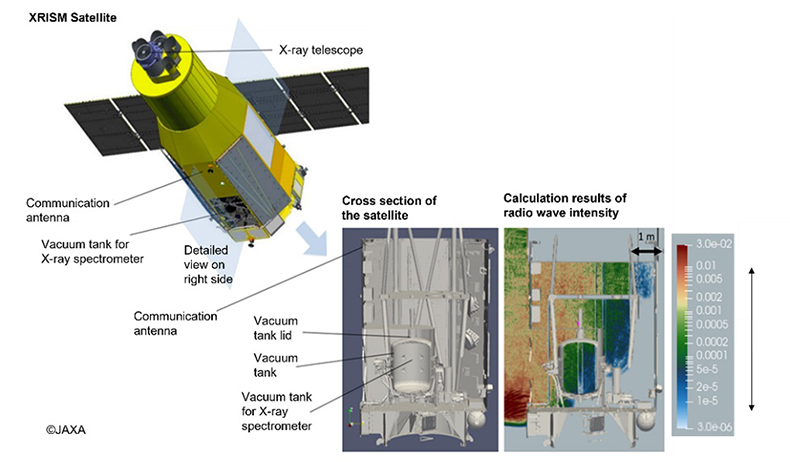 XRISM satellite and electromagnetic wave strength calculation results. If the red area is small, it can be judged that the influence of electromagnetic waves is not a problem for observation performance
XRISM satellite and electromagnetic wave strength calculation results. If the red area is small, it can be judged that the influence of electromagnetic waves is not a problem for observation performance
Comments from Mr. Masahiro Tsujimoto, Associate Professor, Institute of Space and Astronautical Science, JAXA
The fact that we were able to perform high-frequency simulations using CAD models of all satellites with a single solver, which was previously considered computationally difficult, is a major technological advancement in satellite design. In the XRISM satellite project, the results of this simulation played a major role in quantifying untested risks and validating the design.
- 3X-ray spectroscopic imaging satellite XRISM: X-Ray Imaging and Spectroscopy Mission. X-Ray Imaging and Spectroscopy Mission. JAXA's seventh X-ray astronomy satellite project launched in 2018 with the cooperation of NASA and ESA.
- 4X-ray spectrometer: A device that detects electromagnetic waves in the X-ray region by decomposing them for each wavelength.
Rigorous evaluation of the quality of road-to-vehicle communications for the realization of traffic safety and automated driving
In the urban transportation field, we evaluated the communication quality of road-to-vehicle communications assuming 5G environment in the intersection in front of Musashi Nakahara Station on the JR Nambu Line, Nakahara-ku, Kawasaki City.
The quality of inter-vehicle and roadside-to-vehicle communication is affected by surrounding buildings, roadside objects, other vehicles, etc., in addition to the communication distance. Since the impact of these factors increases as communication speed increases, it is important to evaluate communication quality to stabilize communication in high-speed 5G. However, it has been impossible to consider the impact of buildings and objects with complex shapes in simulations using the approximate solution method.
Therefore, Fujitsu conducted a communication quality evaluation of roadside-to-vehicle communications between a transmitter installed at an intersection and a receiver installed in a car, while taking into account the effects of complex shapes of buildings, roadside objects, and cars, through large-scale electromagnetic simulation in a cloud environment using Poynting. (Analysis size: 1 trillion grid, analysis time: about 3 hours)
As a result, it was confirmed that rigorous electromagnetic wave simulations that take into account even complex shapes of wavelength order5 can be performed over a wide analysis area of the urban model scale, and that the effects of buildings and objects can be taken into account.
In addition, the strength and delay spread6 of the radio waves received from the transmitter installed at the intersection by the receiving antenna of each car were directly calculated using the FDTD method simulation to achieve a rigorous communication quality evaluation.
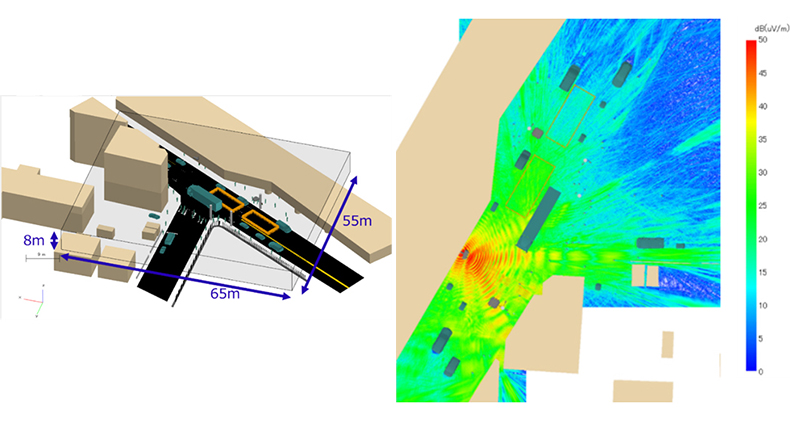 Left: Analysis model overview, Right: Analysis results (electric field strength distribution [4.7 GHz]).
Left: Analysis model overview, Right: Analysis results (electric field strength distribution [4.7 GHz]).
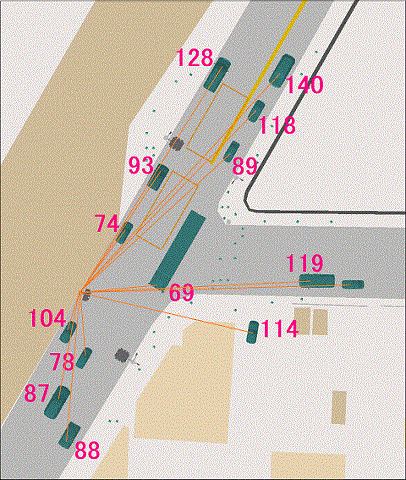 Analysis results: delay spread (unit: nanoseconds). Confirmation that delay spread, which could not be accurately measured by the approximate solution method, can be simulated with values close to the actual measured values
Analysis results: delay spread (unit: nanoseconds). Confirmation that delay spread, which could not be accurately measured by the approximate solution method, can be simulated with values close to the actual measured values
- 5Wavelength order: A length close to the wavelength of an electromagnetic wave (e.g., about 6.4 cm for 4.7 GHz). If the shape of the object has a complexity less than about this length, the approximate solution method cannot be used in the simulation of electromagnetic waves and must be solved by an exact solution method such as the FDTD method in Poynting.
- 6Delay spread: An index that affects the error rate in digital communications. If the value becomes larger, the communication throughput speed will decrease.
Solving social issues by providing highly accurate electromagnetic wave simulations as a service that anyone can use
Finally, we interviewed people in charge of promoting the cloud services for electromagnetic wave simulations, who were involved in this demonstration experiment, about his thoughts on the initiative.
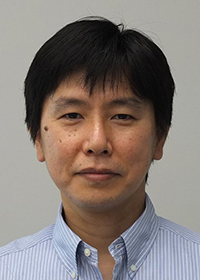
Hikaru Inoue, General Manager, HPC Service Development Dept.
CaaS Strategy Office, Uvance Core Technology Division
Poynting is an application that analyzes invisible electromagnetic waves. Until now, the application of this technology has been limited to small electronic devices because of the high computational power required to precisely analyze electromagnetic waves. However, the dramatic improvement in computing power represented by Fugaku has made it practical to apply electromagnetic simulations to familiar social issues, such as the analysis of wireless communications for an entire intersection.
Now that wireless communication has become an indispensable infrastructure for daily life, the combination of electromagnetic simulation and high computational power is becoming increasingly important as a design tool for electronic devices, automobiles, and urban infrastructure that support a safe and secure society.
In the future, the combination of Fujitsu Cloud Service HPC—PRIMEHPC FX1000— and Poynting will be offered as a CaaS core application to help solve various social issues.
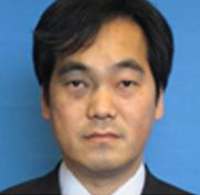
Yoichi Kochibe, HPC Service Development Dept.
CaaS Strategy Office, Uvance Core Technology Division
This JAXA analysis case study is an example of using simulation to solve the difficult problem of quantitatively evaluating the weak level of electromagnetic interference to observation equipment in the operating state of an X-ray space telescope in space, which cannot be reproduced by experiments on the ground.
The 5G communication quality evaluation is an example that demonstrates the new applicability of electromagnetic simulation in road-to-vehicle and inter-vehicle communications, which will be essential for future automated driving. This can also be applied to local 5G communications in offices and factories.
In the future, this simulation technology will be offered as a CaaS service application for Fujitsu Cloud Service HPC. The analysis for electromagnetic interference evaluation can be used by electronic devices manufacturers, and the analysis for 5G communication quality evaluation can be used by customers in telecommunication carriers and automobile-related industries.
This analysis was conducted as part of the joint research project Development and Demonstration of the Fugaku ISV Usage Environment, which is aimed at demonstrating cloud-like usage of the supercomputer Fugaku (Project No. ra010012), with computational resources provided by RIKEN.
Related Information
- [Article]Toward a sustainable society where world-leading computing technologies are available to all
- [Solutions website] Electromagnetic wave analysis solution Poynting for Microwave
- [Solutions website]Fujitsu Computing as a Service(CaaS)
- [Solutions website]Fujitsu Uvance(Sustainable Manufacturing)


